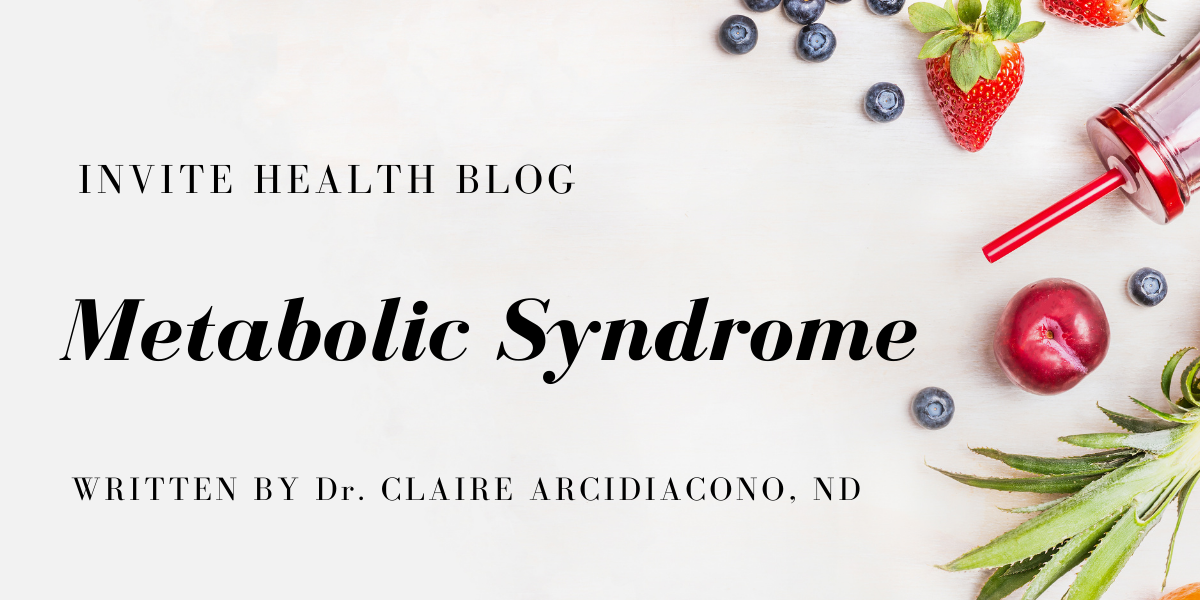Written by Dr. Claire Arcidiacono, ND
For further questions or concerns email me at [email protected]

So far in this series we have talked about quite a few different variations of high blood sugar. Metabolic syndrome is a huge risk factor for developing type 2 diabetes. However it is a very complex concern that I felt it needed its very own blog. What exactly is metabolic syndrome? Metabolic syndrome occurs when an individual has at least 3 of the following: abdominal obesity, high blood pressure, high blood sugar, high triglycerides and low HDL. In the United States 25% of adults have metabolic syndrome.† (1)
One of the most visible signs of metabolic syndrome is what is known as central obesity. Central obesity is what is colloquially referred to as being “apple shaped”. According to the World Health Organization (WHO) central obesity is defined in men where there is a waist: hip ratio >.90 and in women .85. The WHO also classifies a BMI >30 as central obesity. (2) If you are curious as to what that means in inches the American heart association (AHA) says a waist circumference of > or equal to 40 inches in men or 35 inches in a female is classified as central obesity.† (3)
COMMON RISK FACTORS
The risk factors for obesity include a dietary intake of calories that is greater than what is used. (4) In addition to this, there is evidence that a high intake of Trans fats and sugar can increase risk of central obesity. (5) Other risk factors include a high meat diet as well as a diet high in processed foods. (6) In men (but not women) Alcohol consumption is also a risk factor. (7) Stress is another known risk factor. (8) Central obesity is a complex issue with many risk factors. In this article I just covered the most common risk factors.†
HIGH BLOOD PRESSURE
High blood pressure is basically where the pressure in the arteries is higher than normal. High blood pressure is considered to be present when there is a consistent blood pressure reading of 130/80 – 140/90. One of the most common causes of high blood pressure is where plaque builds up in the arteries causing both a blockage in the artery as well as the artery wall to become “hard” so that it can’t expand to allow a greater amount of blood to flow. One way to think of this is to think of blood pressure as being similar to water pressure in a hose. The water in the hose is under a certain amount of pressure so it can move through the hose. If you constrict the hose then more pressure is needed for the water to go through it, the water pressure is higher. The same is true for blood in our arteries. There are different causes for blood pressure to be elevated and narrowing of our arteries is just one. High blood pressure is classified as either primary or secondary hypertension. Approximately 90-95% of high blood pressure is primary hypertension. Primary hypertension is defined as high blood pressure that is due to nonspecific lifestyle and genetic factors. These factors can include excess salt, smoking, alcohol intake and obesity. Secondary hypertension which makes up the remaining 5-10% of all cases of high blood pressure has an identifiable cause. These include kidney disease, having an endocrine disorder, or using birth control pills. While hypertension rarely has symptoms there can be headaches, feeling lightheaded, vertigo, tinnitus and even fainting spells! (9)High blood sugar has been covered in depth in the previous 2 blogs. For the high blood sugar risk factors as well as symptoms that is associated with metabolic syndrome I would refer to the prediabetes blogs as well as the type 2 diabetes blog.†
ICYMI: PREDIABETES>>READ NOW!
High triglycerides is exactly what it sounds like. On a blood test, triglycerides are high. Most people with high triglycerides have no signs or symptoms which is why routine blood work is so important. High triglycerides are diagnosed when triglycerides are over 150 mg/Dl. Risk factors for high triglycerides include obesity, high blood sugar excess alcohol intake, kidney failure, genetic predisposition, lipoprotein lipase deficiency, cholesterol storage disease. Even certain medications can increase triglycerides. Certain chronic diseases such as hypothyroidism, lupus, and glycogen store disease are also risk factors.† (10)
HDL is what is usually referred to as “good cholesterol”. The higher the HDL level the more cardio-protective it is considered to be. Conversely the lower the HDL the higher the risk of cardiovascular disease. Blood tests for HDL that are under 40 for men and under 50 for women are considered to be low. If the blood test is between 40-59 for both men and women it is considered to be at a medium level. If the blood test shows that HDL is above 59 it is considered an optimal level. Diet and lifestyle are risk factors for low HDL. If the diet has low unsaturated fats and high trans fats, as well low omega 3s, this is a risk factor for low HDL.†
LIFESTYLE RISK FACTORS
Other lifestyle risk factors include obesity, high alcohol intake, smoking and a lack of activity. Stress is also a risk factor for low HDL.†(11)
SUMMARY
As I said in the beginning metabolic syndrome is a complex topic. In this blog I have broken down the syndrome by each individual component. Next week we will be continuing on with metabolic syndrome, however I will be putting together all the pieces. What are the general risk factors for metabolic syndrome? What are the possible complications of metabolic syndrome? Lastly what can be done to help combat metabolic syndrome?†
DIABETES TYPE 2>>READ NOW!
For further questions or concerns, email me at [email protected]†
REFERENCES
Falkner B, Crossbow ND (July 2014). “Prevalence of metabolic syndrome and obesity-associated hypertension in the racial ethnic minorities of the United States”. Current Hypertension Reports. 16 (7): 449. Doi: 10.1007/s11906-014-0449-5. PMC 4083846. PMID 24819559.
Alberta KG, et al. (1999). “Definition, Diagnosis, and Classification of Diabetes Mellitus and its Complications” (PDF). World Health Organization. pp. 32–33. Archived from the original (PDF) on 21 August 2014. Retrieved 25 March 2013.
Grundy SM, Brewer HB, Coleman JI, Smith SC, L’Enfant C (January 2004). “Definition of metabolic syndrome: Report of the National Heart, Lung, and Blood Institute/American Heart Association conference on scientific issues related to definition”. Circulation. 109 (3): 433–38. Doi: 10.1161/01.CIR.0000111245.75752.C6. PMC 1880831. PMID 14744958.
Stanhope KL, Havel PJ (March 2010). “Fructose consumption: recent results and their potential implications”. Annals of the New York Academy of Sciences. 1190 (1): 15–24. Bibcode: 2010NYASA1190…15S. Doi: 10.1111/j.1749-6632.2009.05266.x. PMC 3075927. PMID 20388133.
Kho-Banerjee P, Chu NF, Spiegelman D, Rodner B, Cowlitz G, Willett W, Rim E (October 2003). “Prospective study of the association of changes in dietary intake, physical activity, alcohol consumption, and smoking with 9-y gain in waist circumference among 16 587 US men”. The American Journal of Clinical Nutrition. 78 (4): 719–27. Doi: 10.1093/acne/78.4.719. PMID 14522729.
Monteiro, Carlos Augusto; Cannon, Geoffrey; Mubarak, Jean-Claude; Levy, Renata Bortuzzo; Loused, Maria Laura C.; Jaime, Patricia Constanta (January 2018). “The UN Decade of Nutrition, the NOVA food classification and the trouble with ultra-processing”. Public Health Nutrition. 21 (1): 5–17. Doi: 10.1017/S1368980017000234. ISSN 1368-9800. PMID 28322183.
Schroder H, Morales-Molina JA, Bermejo S, Barrel D, Mandolin ES, Gray M, et al. (October 2007). “Relationship of abdominal obesity with alcohol consumption at population scale” (PDF). European Journal of Nutrition. 46 (7): 369–76. Doi: 10.1007/s00394-007-0674-7. PMID 17885722. S2CID 7185367.
Carey D.G.P. (1998). Abdominal Obesity. Current Opinion in Lipid ology. (pp. 35-40). Vol. 9, No 1. Retrieved on April 9, 2012.
Pouter NR, Prabhakaran D, Caulfield M (August 2015). “Hypertension”. Lancet. 386 (9995): 801–812. doi:10.1016/s0140-6736(14)61468-9. PMID 25832858. S2CID 208792897.
Pejic RN, Lee DT (May–Jun 2006). “Hypertriglyceridemia”. Journal of the American Board of Family Medicine. 19 (3): 310–316. doi:10.3122/jabfm.19.3.310. PMID 16672684.
https://en.wikipedia.org/wiki/High-density_lipoprotein










